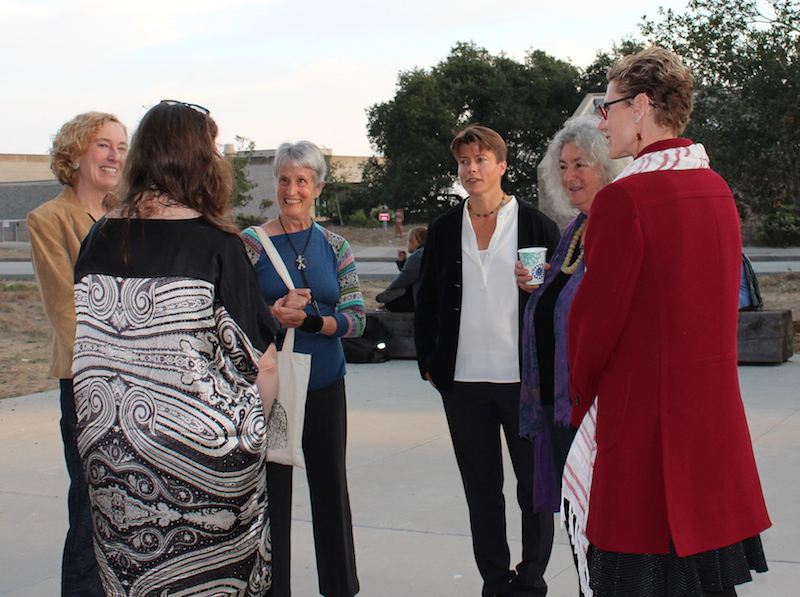Report by Chessa Adsit-Morris
On October 18, 2017, the Center for Creative Ecologies co-sponsored A Public Conversation with Donna Haraway and Starhawk: Magic, Figuration & Speculative Fiction as Calls to Action, an event in collaboration with the Science and Justice Research Center (SJRC)*, bringing together Donna Haraway and Starhawk to dialogue around questions about their lifetimes of activism and writing in a conversation moderated by SJRC Visiting Scholar and organizer of the event, Joan Haran. The event explored the convergences and divergences of their respective work particularly focusing on the role of imagination and science in shaping narratives of the near future. This dialogue was part of a larger SF workshop (including speculative fiction, science fiction and speculative fabulation) which took place earlier in the day, aimed at providing a platform for thinking about our collective responsibility to reshape modes of being if we are to hold open the possibility of flourishing for future generations of humans and non-humans alike. During the public dialogue, both Haraway and Starhawk discussed the environmental and social justice activist movements that inspired their work including the Livermore Action Group (LAG) and the anti-nuclear movement, the Occupy movement, Standing Rock and the Black Lives Matter movements. In particular they both discussed the importance of alternative forms of organizing that foster creative collaborative acts of response-ability (i.e. the ethical practice of capacitating response).
Dr. Haran invited Starhawk and Haraway to reflect on the ways in which they have addressed their readers and students to engage and empower them. In particular, she inquired into their innovative and creative rhetorical strategies, and about the ways in which they are both motivated by speculative fictions and use them to motivate others. Throughout the evening the dialogue centered on their shared commitment to “staying with the trouble,” avoiding end-of-times apocalyptic and post-apocalyptic narratives—particularly those that “leap over” the existing capitalistic, racial and environmental issues we are currently grappling with, and choose to portray dystopian fascist and/or hyper-capitalistic futures—choosing instead to imagine how the struggle against these oppressive and destructive forces might play out. Highlighting the importance of the imagination in crafting narratives that are sensual and affective; inspire worldly action; and alter normative and deterministic understandings the future by opening up possibilities for people to think otherwise. As Dr. Haran noted: “Our shared visions might emerge from the actions we take, or they might co-emerge or be co-created, but the important point is that we don’t regard the practice of imagining as simply escape or retreat from the world.”

From left to right: Katharyne Mitchell, Joan Haran, Donna Haraway, Jenny Reardon, Starhawk, and Marlene Tromp
The generative conversation traversed topics as broad as education, activism, volunteerism, neighborliness, science, reproductive justice, and the dismantling of labor unions. Drawing on personal experiences working in and around disaster zones, they both illustrated how, as Haraway notes, there is always “more than you thought, and less than there should be.” They both spoke about the specific practices they undertake and relationships they nurture to balance their urgent critical concerns with joy, playfulness and pleasure—the delicate balance of love and rage. Rejecting the easy dualisms and dichotomies of modernism and disaster capitalism, they focus on the alternative histories always present that can awaken a sense of what Haraway terms “response-ability”; explaining that “science is made but not made up,” raising onto-epistemological political figural fictional questions around the ongoing struggle of the contestation of stories—which stories get to be told, by whom, and for whom—choosing to continue to partake in the larger shared task of using science fiction, speculative fabulation, lively figurations, anarchist activism, and teaching to produce, what Haraway calls, “worldly interference patterns.”
*The event was additionally sponsored by UCSC’s Center for Agroecology and Sustainable Food Systems, Departments of Anthropology, Feminist Studies, History of Consciousness, Philosophy, Sociology, Division of Art, E.A.R.T.H. Lab and OpenLab.
